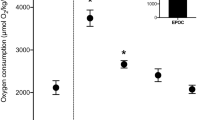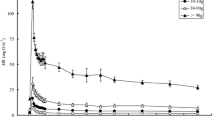Abstract
Burst swimming increased haematocrit (partly from erythrocyte swelling) in the cryopelagic nototheniid Pagothenia borchgrevinki, but not in the benthic species Trematomus bernacchii. Erythrocyte nucleotides, which regulate haemoglobin-oxygen affinity, remained constant. Plasma cortisol was high in all captive fish and raised questions about the effects of chronic stress on metabolic measurements from Antarctic fish held in captivity. Glycogen was reduced in white trunk muscle, but not in the red pectoral muscle of exercised P. borchgrevinki. Red pectoral muscle glycogen was nearly 3 times higher in T. bernacchii than in P. borchgrevinki but post-exercise lactate rises were modest. Lactate values were, however, higher in exercised P. borchgrevinki white muscle than in T. bernacchii, and correlated with muscle-buffering capacity. Resting adenylate energy charge (AEC) was unexpectedly low in both species and reduced with exercise only for white muscle in P. borchgrevinki. While it appears that the capacity for burst swimming is limited by endogenous metabolic fuels, confirmation of low resting values of ATP and AEC in Antarctic fishes requires the development of methods that maintain high phosphocreatine levels in the muscle.
Similar content being viewed by others
Author information
Authors and Affiliations
Additional information
Received: 12 February 1996/Accepted:1 May 1996
Rights and permissions
About this article
Cite this article
Lowe, T., Wells, R. Exercise challenge in Antarctic fishes: do haematology and muscle metabolite levels limit swimming performance?. Polar Biol 17, 211–218 (1997). https://doi.org/10.1007/s003000050124
Issue Date:
DOI: https://doi.org/10.1007/s003000050124




